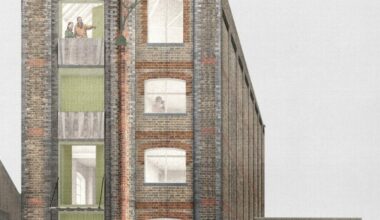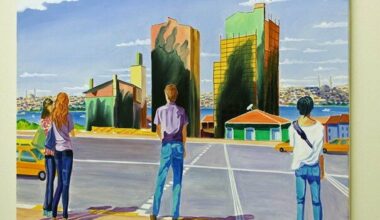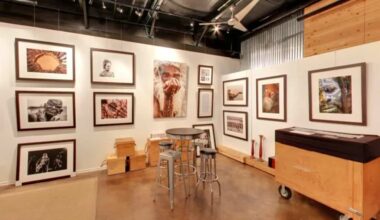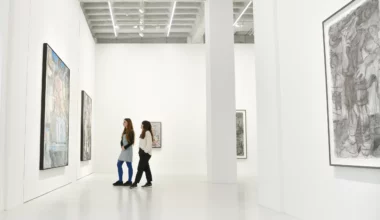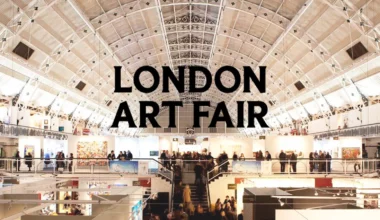As the artistic director of Serpentine in London, Hans Ulrich Obrist has long been a proponent of forward-looking art. This year, Obrist, whom the New Yorker once dubbed “the curator who never sleeps,” took this vision further by declaring 2024 the “Year of AI” at the prestigious institution.
Since joining Serpentine’s leadership in 2006, Obrist has transformed the gallery into a kind of experimental laboratory. He has introduced groundbreaking projects such as Cécile B. Evans’s AGNES, commissioned for Serpentine’s website in 2014; Ian Cheng’s “sentient artwork” BOB (Bag of Beliefs) and Emissaries, a “self-playing video game,” in 2018; and NEW FICTION in 2022, where KAWS showcased his works both at Serpentine and in the digital world of Fortnite.
Serpentine’s 2024 “Year of AI” began with Refik Anadol’s Echoes of the Earth: Living Archive, an exhibition featuring works derived from visual data of coral reefs and rainforests. This initiative will continue in October with an exhibition by Holly Herndon and Mat Dryhurst that explores AI-assisted music-making technologies and the role of AI in the evolving creative economy. Additionally, the institution published Future Art Ecosystems 4: Art x Public AI, the fourth in a series of reports stemming from Serpentine-led research into technological developments affecting the art world, following previous reports on decentralized tech, the metaverse, and advanced technologies.
In light of this dynamic year and its origins, ARTnews engaged Obrist in a conversation about his early fascination with cybernetics, the creation of a dedicated Arts Technologies department at Serpentine, and his thoughts on the rapidly evolving landscape of AI in art.
When did your interest in AI-related art begin? How far back does this curiosity extend?
I’ve been intrigued by AI for quite some time—dating back to my student days, really. When I started curating in the early ’90s, I was inspired by Billy Klüver and the Experiments in Art and Technology (E.A.T.) initiative. I even met Billy, who, along with Robert Whitman, launched that groundbreaking project with Bell Laboratories. I was curious about what a contemporary E.A.T. might look like and how art, science, and technology could be brought together today. My involvement with the Academy for the Third Millennium also connected me with many scientists. Interestingly, it was Bruce Sterling, one of the pioneers of cyberpunk alongside William Gibson, who first got me into email in the early ’90s—a time when not many people had it. He directed me to a cybercafé to set up an account, and I began seeking out others in the art world who were online.
It’s essential to remember that this current wave of AI isn’t the first. Stuart Russell’s book Human Compatible: Artificial Intelligence and the Problem of Control (2019) highlights various key moments in AI’s development since the 1960s. Many early AI enthusiasts were into cybernetics, and my gateway into this world was Heinz von Foerster. I got to know him—he was part of the second generation of cyberneticians, worked with Norbert Wiener from the mid-’40s, and co-founded the field of cybernetics. I remember having conversations with him when I was in my early 20s, and he was in his 80s. He explained cybernetics and its circularity to me, and he was the first to tell me that AI would be significant. At that time, there was more optimism about AI. Stuart Russell discusses how AI’s progress ebbed and flowed, with periods of optimism followed by pessimism. But now, of course, we’re seeing significant advancements.
Early on, there was also an awareness of AI through science fiction. I’ve always been fascinated by Frank Herbert’s Dune and the unrealized film project with Alejandro Jodorowsky and Salvador Dalí. The original text includes a commandment: “Thou shall not make a machine in the likeness of a human mind.”
Serpentine established its Arts Technologies department in 2014, a decade ago. What prompted this initiative, and how would you describe its early years?
I was interested in creating something akin to Experiments in Art and Technology but wasn’t sure where to start. Then, after giving a talk at a TED conference in Marrakech—where David Chipperfield discussed the future of museum architecture, and I talked about curation—a young technologist from London, John Nash, approached me at a party. He remarked that museums were lagging behind in technology and asked why no art institution had a chief technology officer. This idea had been on my mind for some time, but I didn’t know where to begin. John was part of a fascinating group in London, including Dean Kissick, now a well-known writer in New York; Ed Fornieles, an artist who worked early on with blockchain; and Ben Vickers, a guru of art and technology who was also heavily involved in education. Meeting Ben felt like discovering the person we had always been looking for—someone who was both a technologist and an artist, serving as a bridge between the two worlds, with a passion for creating art accessible to all through technology.
Within 48 hours, we invited Ben to join Serpentine. Initially, he was the curator of digital, but it took time for the department to take shape. Once it did, we began launching one project after another, initially focusing on the website. One of the first online projects was by Cécile B. Evans, who created a bot as an early AI project that still exists on our site. We also collaborated early on with Ian Cheng. As time passed, it became clear that we wanted to bring these digital projects into the physical exhibition space. At that time, most museums would only display tech-related projects on their websites. It was similar to how video art was treated in the ’80s and early ’90s—it was marginalized and didn’t have the same presence as painting or sculpture. I recall Bruce Nauman projecting video art large-scale in exhibition spaces in the ’90s, which paved the way for artists like Isaac Julien and Pipilotti Rist.
Technology hadn’t yet achieved that level of visibility, so we decided to grow the Arts Technologies Department and build a larger curatorial team to produce and exhibit work. This approach has enabled us to create AI exhibitions, like our upcoming project with Holly Herndon and Mat Dryhurst, opening in October as part of our “Year of AI.” Earlier this year, we opened a show by Refik Anadol. We’ve also ventured into producing video games—last year, we hosted an exhibition by Gabriel Massan, a young Brazilian artist who always dreamed of creating a video game.
What do you see as the common thread among these diverse projects?
The core idea is to realize artists’ dreams. We also aim to foster new alliances with technology partners. We’ve collaborated with the Google Cultural Institute on several projects and worked on a tech project with Jakob Kudsk Steensen and BTS, which forged a significant alliance with K-pop. Additionally, our partnership with KAWS and Acute Art brought art into Fortnite, where we reached an audience of 150 million people. This project was especially impactful, as tens of thousands of young people brought their parents to the gallery—an unusual phenomenon. It sparked interest in a new generation. We also consider how these technologies can benefit the public sector, which is why, in addition to exhibitions, we publish our FAE reports. These reports aim to support artists globally and diversify audiences.
The latest Future Art Ecosystems report focuses on “Art x Public AI.” How has the response been so far? Has anything surprised you or made you reconsider its findings?
Impact takes time. Over the last decade, we’ve worked with numerous artists on these projects. For example, with Ian Cheng, we launched an AI project in the gallery in 2018. The visitor book and digital comments revealed a wide range of reactions—some people returned daily because they felt Bob, the AI character Ian created, was kind to them, while others found Bob cold and unresponsive. This interaction showed how the artwork functioned as a living organism, which has been a recurring theme in our exhibitions with artists like Pierre Huyghe, Philippe Parreno, and Hito Steyerl.
The concept of the artwork as a living organism, with feedback loops and learning systems, marks a significant shift in the art world. This evolution is not limited to digital work—it’s also happening in analog contexts. Our ecology department, for example, recently hosted a conference on artists’ connections to land, with more and more artists building gardens and farms.
In response to your question, the impact of our work is gradually extending beyond the art world. Our FAE reports have been valuable for other museums exploring how to engage with technology. These reports are strategic briefings based on extensive interviews with artists and technologists conducted by our technology team. This year’s report on AI has generated the most interest so far, with institutions worldwide eager to engage with AI. Our exhibitions have also seen record-breaking attendance, like the Refik Anadol show, and there’s tremendous excitement for the upcoming show with Herndon and Dryhurst. It has taken time to build this momentum, but we’re now seeing it expand beyond the art world.
What have you learned from working with artists on these projects?
Over the past 10 years, we’ve gained valuable insights from artists. As an institution, we must remember that artists can change us. For instance, we spent two years collaborating with Gabriel Massan on a video game project and almost two years with Herndon and Dryhurst on their upcoming exhibition. Their work with music and machine learning is particularly interesting because they consider not just what AI can do for them but what it can do for other artists. They’ve developed a model that enables collaboration among artists, and they’re using Serpentine as a platform to foster these new alliances.
One of the most memorable projects was with KAWS in Fortnite. Initially, people thought it was too much for a gallery to engage in gaming. However, KAWS helped us enter the gaming world, and the reception was extraordinary. Thousands of young people began visiting the gallery, and we now see video games as a way to connect with future generations. This experience opened our eyes to new possibilities. We also launched the Future Art Ecosystems series after a panel on art and blockchain at Art Basel, where I had no idea what blockchain was. However, we knew that technology was rapidly changing the art world, and artists had great ideas for the future.
Do you have any predictions for how AI will shape the art world in the coming decade?
The future is inherently unpredictable, as evidenced by the shocks we’ve experienced in recent years. In 2019, no one could have predicted the pandemic or how it would transform everything. Predicting the future is difficult, and I don’t want to speculate. Instead, I’m keen to understand the potential impact of AI on art. Last year, when we planned the “Year of AI,” AI art had been around for several years, and artists like Ian Cheng were working with AI in profound ways. But this year, with the public release of DALL-E and ChatGPT, AI has become much more accessible. It’s no longer just an esoteric tool for artists; now, millions of people are using it in their everyday lives. This shift is both exciting and challenging.
In terms of curatorial strategy, we must embrace this moment of great change. The key is to remain open to new possibilities. It’s also essential to remember that AI is a tool—it can enhance creativity but can also raise ethical questions. For example, how do we address the issue of AI-generated content being mistaken for human creation? What are the implications for artists’ rights? These are important questions that we’re just beginning to explore.
Ultimately, AI is just one of many tools artists can use. It’s not about replacing human creativity; it’s about expanding the possibilities for what art can be. This has always been the role of technology in art, from the invention of perspective in the Renaissance to the rise of video art in the 20th century. AI is the latest chapter in this ongoing story, and I’m excited to see where it leads.
Can you share more about the upcoming exhibition with Holly Herndon and Mat Dryhurst?
Holly and Mat are visionary artists who have been at the forefront of exploring the creative potential of AI. They’ve been working on this exhibition for nearly two years, and it’s shaping up to be one of the most exciting projects we’ve ever undertaken at Serpentine. The exhibition will explore the intersection of AI, music, and the creative economy. Holly and Mat have developed a model that allows artists to collaborate with AI in new and innovative ways. The exhibition will feature a series of interactive installations where visitors can experience these collaborations firsthand. It’s a groundbreaking project that pushes the boundaries of what’s possible in art and technology.
One of the most exciting aspects of this exhibition is how it will engage with the public. Holly and Mat are passionate about democratizing access to AI and making these technologies more accessible to artists and audiences alike. They’re also interested in exploring the ethical implications of AI and how we can use these tools responsibly. This exhibition is not just about showcasing cutting-edge technology; it’s about sparking a conversation about the future of creativity in the age of AI. I’m thrilled to see how it will resonate with our audiences.


